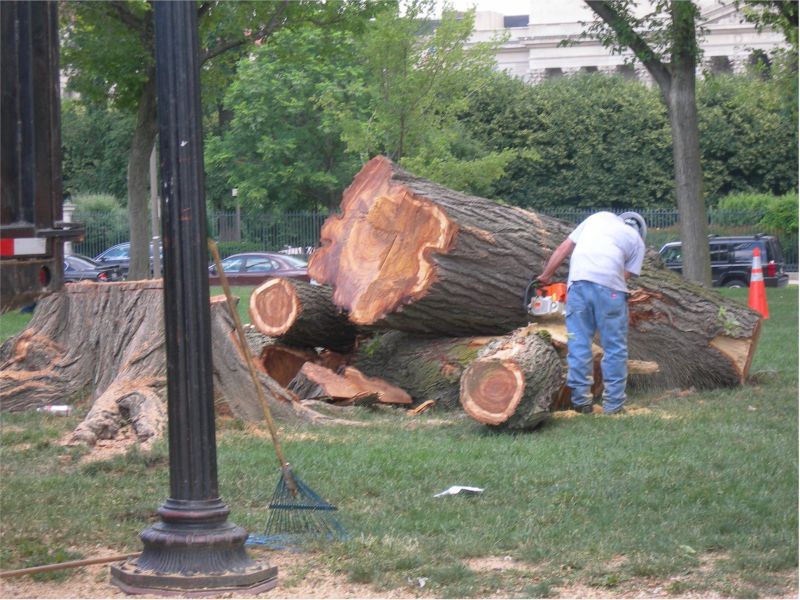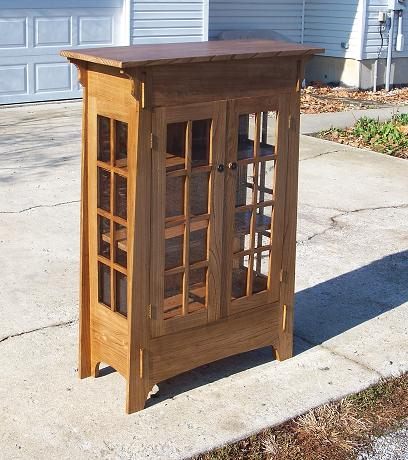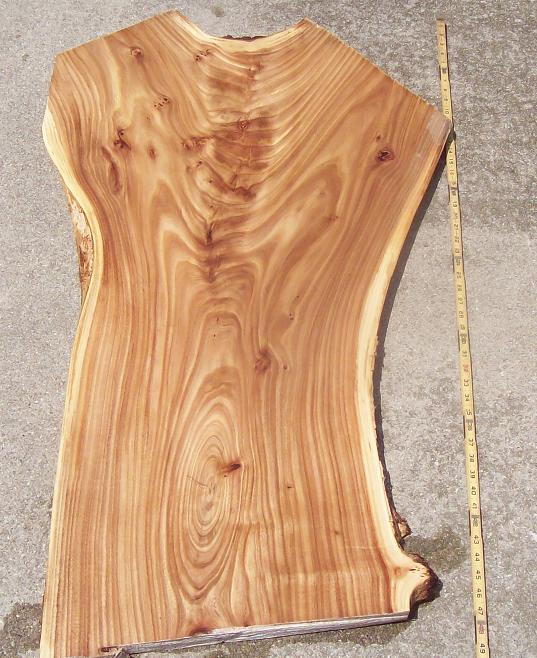Urban Tree: Wasted Opportunity?
A photo of an Elm tree about to be chipped on the National Mall in D.C. sets off a discussion of the value (subjective and market) of urban trees and yard trees. May 11, 2011
Question
See this photo of an elm being cut down on the Mall in DC? It ended up being chunked and chipped. Is this a lost opportunity - something that could have been milled into something useful? Or is chunking, chipping, and the landfill the only practical option? Looks like a red elm; narrow sapwood, reddish brown heartwood.

Click here for higher quality full size image
Forum Responses
(Sawing and Drying Forum)
From contributor K:
I am shocked that anyone in government would ever waste anything! That has to be a Photoshopped picture.
From contributor P:
I think if that were at my mill, I could have cut $150 or so of pallet boards from that log. But since my mill is in Oklahoma, shipping would have only cost 10 times that much at least.
From Professor Gene Wengert, forum technical advisor:
Such a tree is likely bacterially infected and also likely has tramp metal. A ruined sawblade can quickly eat up any profit. As mentioned, the quality in an open-grown tree is likely just pallet lumber.
From contributor D:
We have several urban tree outfits as kiln customers. They find that they can make some serious money processing trees as lumber. Land filling that much wood is also expensive in many places. The urban outfits, and we have several doing this, offer to saw and dry the lumber from trees and people very often want that because the tree has some significance to them. They often don't know what they are going to do with the lumber but buy it anyway. Some of the rest goes into the craft market. There are lots of things to do with the lumber, especially if it is in or near a populated area.
From contributor O:
It seems like the urban tree people are into slabs more than lumber. Big is beautiful, no matter how many defects are in the slab. I have some 16/4 black walnut that a guy left here last week. It hasn't yet been near a kiln, but it is already cracking. Oh well.
From contributor N:
Yeah, you can't make anything but pallets from those old yard elms...

Click here for higher quality full size image
Sarcasm aside, that elm bookcase was built by one of my lumber customers. He paid $2 bft rough sawn/air dried for 4/4. Yard tree from across town, no tramp metal. I just shipped this to Texas. The customer was tickled to pay $100 for the 5/4 elm crotch slab (it was thickness sanded, ready to use). I get $50-$75 rough sawn from my walk in customers for similar. You guys, please just keep turning your noses up at this "junk." It makes it easier for me to get it free and turn a buck on.

Click here for higher quality full size image
From contributor P:
Those are some nice pieces, and no doubt very valuable. I was just saying that when that kind of log shows up at my mill, we make pallet boards from it. I have not developed the markets for furniture lumber or hobby/craft lumber. Those are very viable markets that can pay well - I just don't have them.
From contributor T:
This does not appear to be a red elm.
Gene, why would a tree like this be bacterially infected? I imagine something must have been wrong with the tree for it to have been taken down in the DC Mall, but it does not look rotten or anything. Sure there may be metal inside, but if it fits on a bandmill, the blades are $25.00 apiece, and slabs from this tree should be $200.00+, considering you take the time to find the right buyer, but they are out there.
Being that it came from an important urban city area, it's very likely to be an ornamental species, and there are a hundred possibilities. I have done a lot of work in Central Park, NY and the elms there are a Siberian variety.
Taking down a tree like this is often far more expensive than the log from the tree was worth. In PA, NJ, NY, DE, MD, and Washington DC, a take down for a tree of this size is likely to cost $1,500 at least, maybe even $2,500.00. It costs a lot to afford the insurance, maintain insurance and cover overhead, especially when you're dropping trees around buildings in D.C.
It's a major shame that the tree was wasted, but you must consider what goes into properly harvesting a tree such as this. The expense of chipping and cleaning the area and that's it, or paying $80.00 or so an hour to truck it to a mill, paying at least $500.00 to mill a log like this, taking the time to dry such an unusual species properly, paying a woodworker to deal with it. A log this size may be too big for a typical log truck with a prentice 120C boom, so you will have to hire in a crane for $2,500 a day.
I do sympathize with you though. About two or three years ago I took down a 4-5' diameter red oak in Thomas Edison's front yard. A local tree service was in charge of the job, and called me in to salvage the log, and they even left the tree standing so I could properly timber cut the base as low as possible. I saved a 150+ pound burl that came off the base (luckily I took it home with me that morning in the back of my truck). My log truck was scheduled to go pick up the log the next morning, but got rescheduled from that Friday to Monday. Because of the delay the people in charge of Edison's estate demanded that the tree service remove the log before Saturday morning, so they went and cut it up into firewood without telling me. What a phone call to wake up to! Next time I get a tree like that I'm camping next to it like a hippie!

Click here for higher quality full size image
From contributor K:
Red oaks that size litter this part of NC. I won't even mess with them. White oak, maybe, but I have spent all the time I am going to on red oak. Every week I am told about a 5' diameter tree lying somewhere around town - not interested - those things are time sinks.
From the original questioner:
Thanks for all the comments. It may not be red elm, but it's definitely elm. In the photo you can make out some of the tiny branches and leaves that sprouted directly from the bole, typical of elm growth. The leaves were spade shaped, not lobed. I just guessed red based on the heartwood color. DC has a comprehensive street tree inventory, according to which, 10% are elm, so there's lots of elm here. The city and the National Park Service (which manages the Mall and several other large parks in the city) are pretty aggressive about taking down any elms that show signs of DED. That's my guess why they took it down.
From contributor I:
The value of the wood is in direct proportion to your values. In terms of high end professional wood sales, it seems elm isn't the greatest choice; in terms of not wasting a beautiful natural resource, it isn't such a bad idea at all. Wood is nothing more than the media with which we progress in our professions/interests, and what we use and our efforts to use it is simply up to what we want. If you want to make the effort, see if you can claim a log or three and have it sliced up for use. That cabinet contributor N has sure would look great in my home.
From contributor O:
A few months ago a studio approached me about drying a chunk of elm big enough to make a yoke for a replica of the Liberty Bell. We couldn't find a piece big enough to avoid the pith. They would have paid big bucks for a chunk of that tree. And it was chipped!
From Professor Gene Wengert, forum technical advisor:
Indeed, pallet wood can make fine furniture. However, yields are low, which will mean that profits are likely low, especially when considering production of multiple items (furniture, lumber, etc.). A small operation or hobbyist may have different goals than a commercial operation. A commercial operation may have different goals if they have profit and environmental benefits as equal goals. We do see that most consumers will not pay much extra for "environmentally good" wood products.
From contributor G:
As a CSM advocate, this tree, like many urban trees, always seems to be a wasted opportunity. Especially for places like DC, where both the trees and the crowds grow large. Somebody with an 880, a Mark III and a 6' bar could have made some good slabs out of that tree, entertained a crowd, and still ended up with a bunch of firewood. Cut logs like a government worker cuts red tape - lengthwise.



